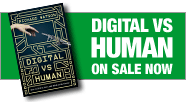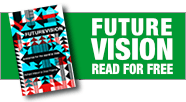Help/FAQ
- What is What’s Next?
- How do I use the report?
- Who’s using What’s Next?
- Where do you source your material?
- How international is your content?
- What does ‘Ref’ refer to at the bottom of each story?
- What does ‘trend tags’ refer to?
- What does ‘source integrity’ refer to?
- What does ’search words’ refer to?
- I want to print the report - what are my options?
- I want to view some older issues - how do I do this?
- Can I use the images on the site?
What is What’s Next?
What’s Next is a report about current and future trends. It’s been published since 2004.
How do I use the report?
That’s up to you. Some people just read it like a newspaper to keep up-to-date and to widen their thinking. Others use it as part of the process for innovation, strategy planning or strategic foresight. Whatever you do with it, the important point is not just to read about ‘your’ industry, sector or discipline. New ideas tend to originate where disciplines, industries and technologies converge or cross-pollinate, so it’s important to know what’s going on in other spheres. The aim, in other words, is to inform you about what’s going on in other places, which may be a catalyst for new ways of seeing and thinking.
Who’s using What’s Next?
What’s Next is read by forward thinkers in leading organisations such as McKinsey, Microsoft, NASA, Ernst & Young, KPMG, BBC, IBM, Wal-Mart, Westfield, Tesco, Best Buy, Coles Myer, Toyota, Ford, Nissan, Disney, McDonald’s, Nestlé, Kraft, PepsiCo, Coca-Cola, SC Johnson, AMP, Commonwealth Bank, St George Bank, National Australia Bank, Westpac, Virgin Atlantic Airways, Gulf Air, Emirates and Intel.
Where do you source your material?
As the author William Gibson said, "the future is already here; it’s just unevenly distributed". This pretty much sums up how this works. I subscribe to a number of key publications and I’m constantly talking to people about new ideas, innovations and trends. The trick is simply knowing where to look and who to talk to — and, of course, having the time to do it.
How international is your content?
Material is primarily sourced from the UK, US, Europe and Australia, because most people tell us that these are the countries they’re most interested in. As a result the reports have a Western bias. However, we do try to keep an eye on interesting developments in other regions.
What does ‘Ref’ refer to at the bottom of each story?
Most stories are sourced from or influenced by other stories, in which case I make a reference to the original publication, article and writer. Stories are always re-written for legal reasons, to reduce overall length and to bring out key points and connections. In some cases there will be various sources and in other cases the story comes from my own research and observations.
What does ‘trend tags’ refer to?
We all learn new information best when we can connect it to information that we already know. Sometimes you’ll find a tag at the bottom of a story, which refers to other key ideas or trends that link to the story. Try using these tags as search words to find connections or patterns. I also use these tags to plot linkages and to track the impact of trends over time.
What does ‘source integrity’ refer to?
Sources are ranked 1-5 depending on integrity and trustworthiness. Hence something that appears in the New York Times will be given the highest five star (*****) rating whilst something that appears in an unknown blog may only rate 1 star (*). We could argue about this for hours so if you don’t agree with the ratings ignore them or tell me why I’m wrong.
What does ‘search words’ refer to?
‘Search words’ is sometimes used as an alternative to trend tags.
I want to print the report - what are my options?
Simply click on ‘print whole report’, or you can print individual sectors.
I want to view some older issues - how do I do this?
The full issue archive can be found in the menu on the left hand side of the page.
Can I use the images on the site?
Yes, but only for internal presentation purposes. You cannot use the images for any commercial purposes or for public display (e.g. seminars or conferences) without written permission.


